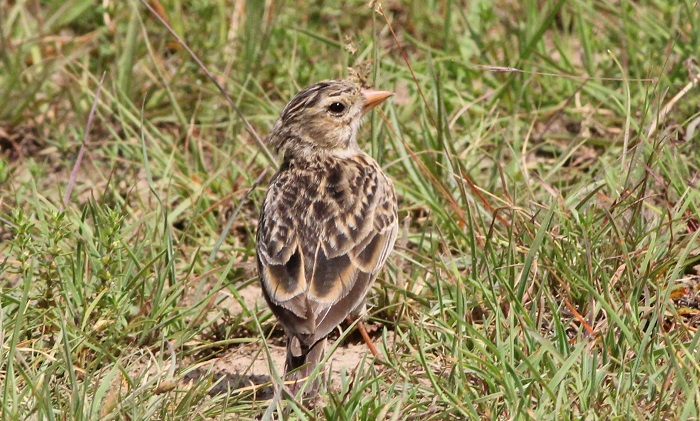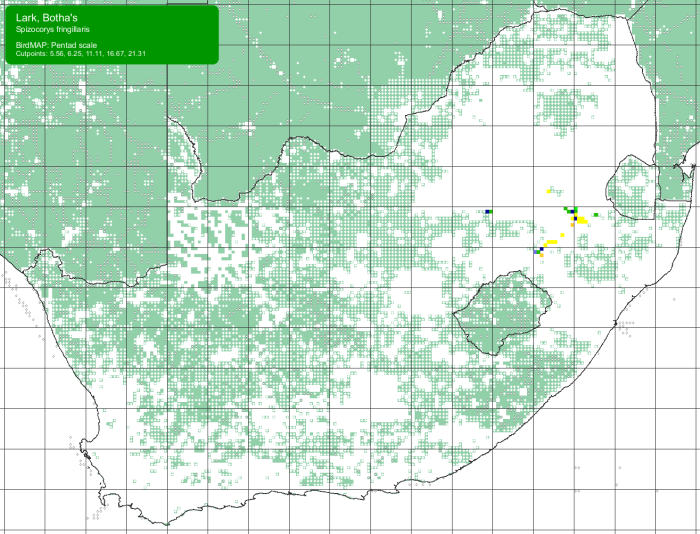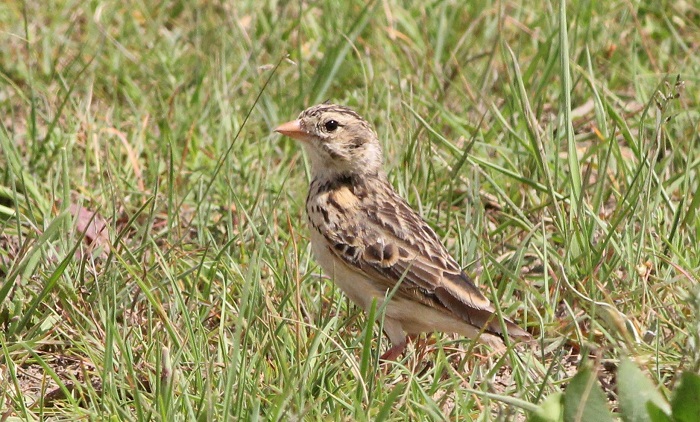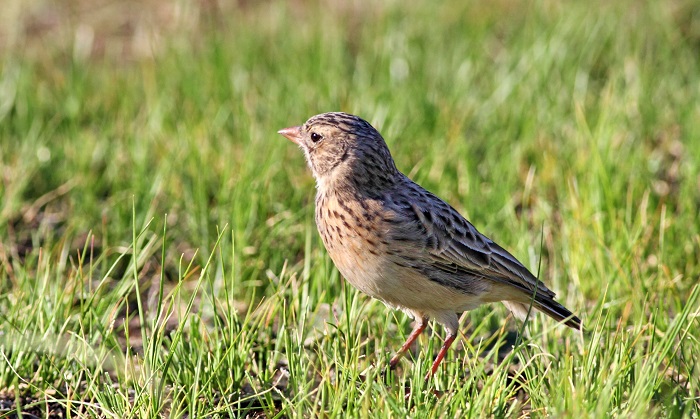Cover image of Botha’s Lark by Maans Booysen – Daggakraal, Mpumalanga – BirdPix No. 213508
Larks are passerine birds of the family ALAUDIDAE. The larks are a group of mostly Old World passerine birds. Most species are found in Africa, followed by Asia and Europe with two species occurring in North America and one species in Australia. Habitats vary, but many are characteristic of open, dry regions. The family contains 21 genera and 100 species.
Identification

Daggakraal, Mpumalanga
Photo by Dave Rimmer
Botha’s Lark is a small species with a short, stout pink bill. The face is relatively plain with pale brown ear coverts. The supercilium is cream or buff-coloured and there is an indistinct blackish eye stripe. The sides of the neck are buffy brown. Upperparts, including the crown, mantle, back and folded wings are brown with prominent blackish streaks. The chin and throat are greyish white and the breast, upper belly and flanks are buff-coloured with a slight rufous wash, heavily streaked in blackish brown. The lower belly and under tail coverts are pale buff to white.
The tail is dusky brown with broad white outer tail feathers. Eyes are brown and the legs and feet are pink. The sexes are alike.

Daggakraal, Mpumalanga
Photo by Maans Booysen
Juveniles resemble the adults but have irregular whitish spots on the crown and back, with buff-tipped flight and tail feathers. The breast has diffuse, brown streaks, lacking the blackish streaks of the adults. The bill is horn-coloured (not pink).

Daggakraal, Mpumalanga
Photo by Maans Booysen
Botha’s Lark is most likely to be mistaken for the Pink-billed Lark (Spizocorys conirostris). The latter has a rufous-buff (not whitish) belly and under tail coverts. It also has less extensive streaking on the breast, a less prominent supercilium, a heavier bill and buffy (not white) outer tail feathers.

Near Wakkerstroom, Mpumalanga
Photo by Johan van Rensburg
Status and Distribution
Uncommon to Rare (formerly locally common) resident and local nomad.
Botha’s Lark is endemic to South Africa and is found nowhere else in the world. It has a very small and restricted distribution, mainly in the Vaal River catchment, from north-eastern Free State to western Mpumalanga.
Botha’s Lark is South Africa’s most threatened terrestrial bird species and is currently listed as Endangered. However, it is soon to be re-listed to Critically Endangered. The population of Botha’s Lark was possibly as large as 20 000 birds in the early 1980s but fell to under 2500 by 2015. The latest estimates from 2023 and 2024 indicate as few as 340 individuals may survive in the wild.

Details for map interpretation can be found here.
Botha’s Lark is patchily distributed within a small range. It does not occur in any protected area, and no longer occurs at the Type locality. Most of its preferred habitat has been transformed by agriculture, over grazing and forestry.

Daggakraal, Mpumalanga
Photo by Maans Booysen
Habitat
Botha’s Lark inhabits short, heavily-grazed upland grassland and dry floodplains. It favours sour grassveld on clay soils. Botha’s Lark avoids longer grass in valley bottoms, poorly drained areas, planted pastures, croplands and rocky places.

Near Wakkerstroom, Mpumalanga
Photo by Maans Booytsen
Behaviour
Botha’s Lark is sometimes seen in small groups of up to 10 birds, but is usually solitary or found in pairs. They are generally resident and sedentary but moves locally in response to veld conditions like fire and drought.

Near Wakkerstroom, Mpumalanga
Photo by Jorrie Jordaan
Botha’s Lark is inconspicuous and easily overlooked. Unlike most larks, no aerial display has been recorded. They flush readily, fanning the tail on take-off (showing white outer tail feathers), and usually flying in a wide circle whilst calling. The flight is undulating and ends with a vertical dive into grass cover.

Near Wakkerstroom, Mpumalanga
Photo by Johan van Rensburg
Botha’s Lark forages in the typical lark manner by walking about briskly while watching the ground, pausing now and then to look around. Occasionally darts after prey or jumps into the air to snatch a morsel, and does not dig for food. Botha’s Lark eats invertebrates, including beetles, grasshoppers and moths. They also consume seeds particularly outside of the breeding season.
Botha’s Lark is dependent on surface water and drinks regularly.

Daggakraal, Mpumalanga
Photo by Maans Booysen
Botha’s Lark is monogamous and nests solitarily or in loose groups. Neighbouring nests can as little as 20 m apart. There is evidence of synchronous breeding among groups, likely to make the most of good veld conditions.
The nest is a cup of dry grass lined with grass strips and sometimes sheep’s wool or hair. The nest is built into an excavated hollow in the ground between grass tufts or on occasion against a small shrub or among sheep dung. The nest is built in 3 days and egg-laying starts 1 to 3 days after nest completion.

Daggakraal, Mpumalanga
Photo by Karis Daniel
Botha’s Lark breeds from October to January, depending on veld conditions. Two or three eggs are laid per clutch at one day intervals. The eggs are cream-coloured, heavily marked with dark brown and grey-brown speckles. Botha’s Lark is single brooded but has been recorded to re-lay within five days of an early clutch failure. Incubation starts upon clutch completion and the incubation period lasts for 13 days. Incubation duties are shared by both sexes.
Chicks are fed and cared for by both parents and are apparently fed almost exclusively on insects, mainly grasshoppers. Adults typically forage nearby and usually fly overhead calling when an intruder approaches. Chicks are ready to leave the nest after a further 11 to 15 days.
Further Resources
Species text for Botha’s Lark in the first Southern African Bird Atlas Project (SABAP1), 1997.
The use of photographs by Dave Rimmer, Johan van Rensburg, Jorrie Jordaan, Karis Daniel and Maans Booysen is acknowledged.
Virtual Museum (BirdPix > Search VM > By Scientific or Common Name).
Other common names: Vaalrivierlewerik (Afrikaans); Finkenlerche (German); Alouette de Botha (French); Botha-leeuwerik (Dutch); Cotovia de Botha (Portuguese).
List of bird species in this format is available here.
Recommended citation format: Tippett RM 2024. Botha’s Lark Spizocorys fringillaris. Biodiversity and Development Institute. Available online at https://thebdi.org/2024/08/02/bothas-lark-spizocorys-fringillaris/

Daggakraal, Mpumalanga
Photo by Maans Booysen


Ryan, the habitat photo belongs in the Lark-like Bunting and not the Botha’s Lark so does two of the photo descriptions.
Hi Roy
Thanks for spotting that. I have fixed it now. Thanks again